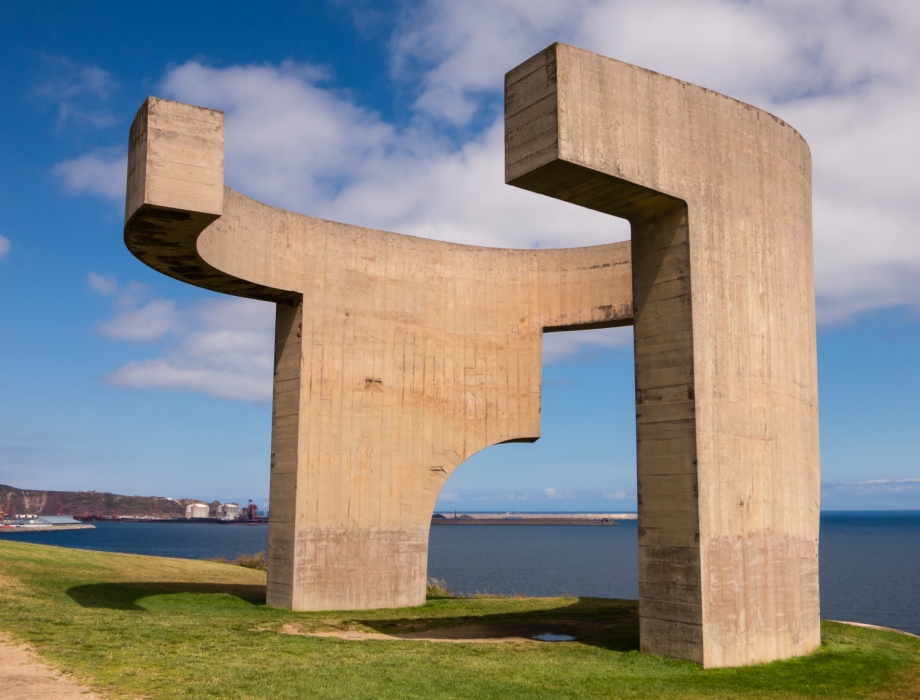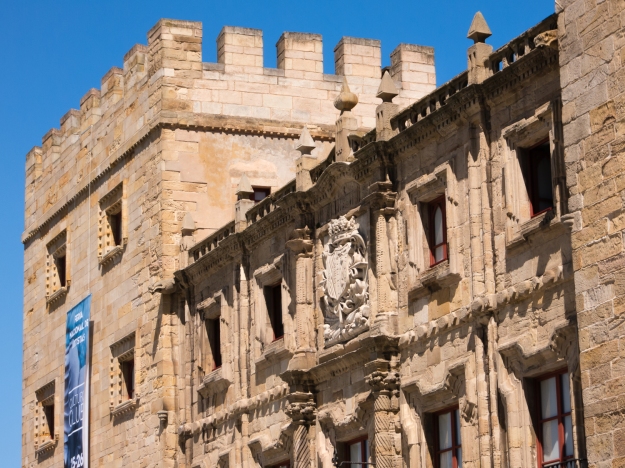From humble beginnings as a fishing village on the Atlantic Ocean coast (locally the Bay of Biscay) nearly 3,000 years ago, Gijón has blossomed into the largest city and major seaport of Asturias (province), Spain.

Cimadevilla (the old fishing district, now the nucleus of Gijón’s nightlife), Gijón, Asturias, Spain
Cimadevilla is Gijón’s birthplace, the former village which retains much of its centuries old charm — from the Roman Therms of Campo Valdes to the Town Hall and statue of Don Pelayo, the first Asturian king, to the baroque-style Revillagigedo Palace (see photograph, below).

Elogio del Horizonte (the symbol of Gijón) by sculptor Eduardo Chillida, 1990, Gijón, Asturias, Spain
Atop Santa Catalina Hill stands Elogio del Horizonte — Praise of the Horizon — a house-sized modern concrete sculpture crowning the lookout between the two halves of Gijón. The monument, by sculptor Eduardo Chillida, has become a symbol of Gijón since its construction in 1990.
From the promontory, there are excellent wide-angle views of the coast and the Bay of Biscay. Facing inland, one can see the verdant hills, considered to be some of the greenest in Spain.

Looking up at Elogio del Horizonte (the symbol of Gijón) by sculptor Eduardo Chillida, 1990, Gijón, Asturias, Spain
While the story is “if you stand just below it, you can hear the noise and the pounding of the waves,” the wind was blowing so strongly on our visit that we could just feel and hear the wind.
Gijón is a walking city — whether up the streets in the historic Cimadevilla neighborhood up to the promontory, or around the port and adjacent to the playas (beaches) that surround the city.
A city landmark, Palacio de Revillagigedo (the Revillagigedo Palace)is an impressive example of 18th century Baroque architecture (our 2 year-old grandson saw the photograph and remarked, “it’s a castle!). The building is now a vibrant culture center hosting interesting contemporary art exhibitions.

Torre del Reloj (Clock Tower), 1572 — now home to the city’s municipal archives, Gijón, Asturias, Spain
Also located in the historic Cimadevilla neighborhood, the Torre del Reloj (Clock Tower) provides a wonderful lookout point over the city. Built in 1572 atop the remains of a defensive tower that was part of the ancient Roman wall that once encircled the city, this pink structure has served many functions over time, including the town hall and a prison. Now it is home to the city’s municipal archives and an exhibition on Gijón’s history.
Adjacent to the Torre del Reloj was this fabulous splash of colors — in stark contrast the most of the surrounding historic sandstone colored Baroque buildings (for example, the Palacio de Revillagigedo, pictured above).






Another great post, Rich!
LikeLiked by 1 person
The clock tower is such a modern contrast to the 19th century baroque buildings that I thought it was contemporary. It is hard to believe that it was built in 1572.
LikeLike
I had the same reaction. Upon checking my notes, I found that what looks contemporary was actually historic. Nice clean lines, in contrast with a lot of the Baroque buildings that followed it in the old historic district!
LikeLike
Hi Rich, We’ve enjoyed another of your travelogues, including your grandson’s “castle”. On Friday, Steven and I flew to London. We’ll be here until the 27th, then leave for Florence. London was 89° on Saturday, but cooled down considerably on Sunday, and today. It’s been raining too – typical of London. It will be hot in Italy. Donna
LikeLike
We had a heat wave earlier in the summer with 46 degrees Centigrade (116 degrees F) in Sevilla (Seville), Spain, while on the coast when we got back it was a much cooler 39 degrees C (102 F) in Cadiz! You’re visiting some beautiful cities — have a great time.
LikeLike
Never heard of this city. Looks like one of incredible contrasts.
LikeLike
Before we study the itinerary for each year (set three years in advance!) we find many small islands, towns, and cities that we have never heard of. That’s a great thing about sailing around the world every two years — new discoveries blended in with visits back to “old friends”. Right now, a lot of first time port calls for us.
LikeLike
Rich,
If you like going to places you never heard of, I suggest you get a copy of a book called “Report from Practically Nowhere” written by my cousin, the late John Sack, about four decades ago.
Paul
LikeLike